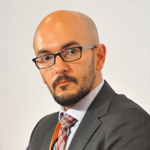

 Mr. David Ríos Morentin
Mr. David Ríos Morentin MsC in Telecommunications Engineering and Master in Defence and Security Business Administration, David Ríos is a Senior Consultant and Project Coordinator at ISDEFE’s Intelligence and Homeland Security Division. Having worked as a consultant for the Spanish Guardia Civil in the definition, development and integration of the spanish Integrated Maritime Border Surveillance System (SIVE), he currently supports Spanish and EU Users and institutions in the definition, testing and validation of innovative border surveillance systems and in the drafting of new procedures, strategies and concepts of operation .
There is a strong perception that the success of maritime surveillance operations is very much linked to the technical capacities available, and therefore, research and innovation in this field has gained a prominent position during the last years.
Maritime borders represent an unstable environment in terms of threats, trends, social/economic growth and regulation, where all the elements of the overall system must adapt to constant changes. This includes technology, which needs to be fit not only for the situation we are living today, but also for whatever is coming in the future.
Therefore, there is a strong need to know what is the capability building space and what is the growth margin from the current situation to an upgraded and fully performant surveillance system. The truth is that there is always margin for improvement, but strengthening the backbone of innovation from the concepts to the market sometimes poses serious difficulties.
Indeed, innovation does not always reach the market, and all indicators point at market visibility as the main obstacle. Both the visibility of the demand and the visibility of the offer are limited with traditional approaches, so new mechanisms are required to increase both. In this sense, the full involvement of end users and authorities in the innovation process should be seen as a catalyzer for innovation, and their participation in EU funded RTD project should be strongly encouraged by all stakeholders, including the public administration, academia, research organizations and private industry.